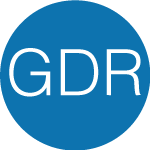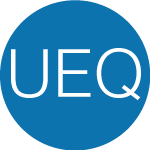Assessments | SEI Core EQ Tool | SEI
Six Seconds
Emotional
Intelligence
Assessment (SEI)
Measure and improve emotional intelligence.
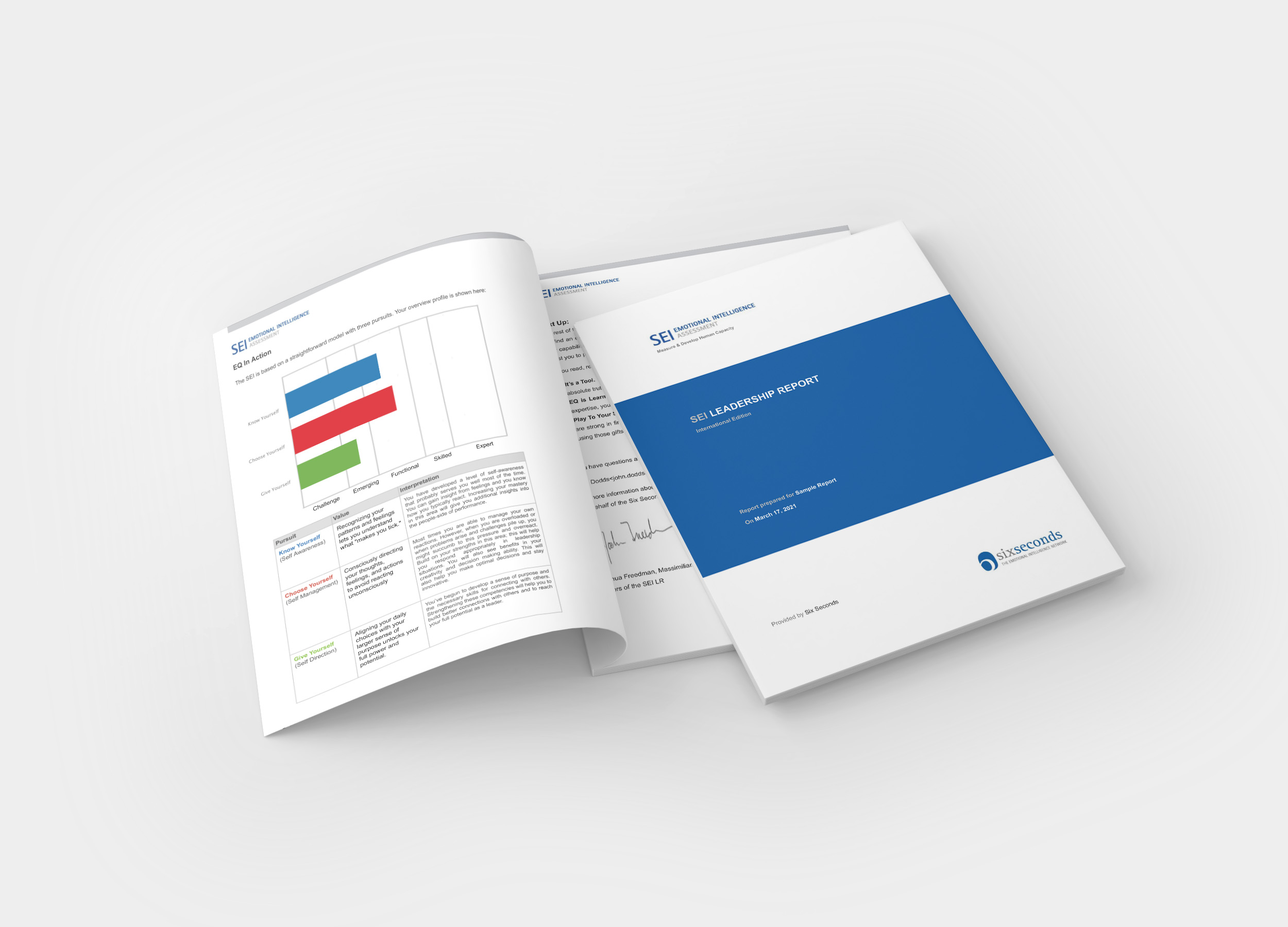
The Six Seconds Emotional Intelligence Assessment (SEI®)is the complete solution for EQ measurement and development. This suite of well validated, effective tests measure EQ and equip people with a framework for putting emotional intelligence into action.
SEI is used in over 150 countries for a broad range of training, coaching, selection, and development needs in orgs from FedEx to Qatar Airways to the U.N. SEI is best-in-class because of the blend of robust psychometrics, real-world practicality for a wide range of needs, and global relevance.
What makes SEI such an effective assessment tool?
Where several other EQ tools provide meaningful feedback, the SEI is unique because it’s not JUST feedback, it delivers a process framework that equips people to actually USE emotional intelligence (here is a comparison of some of the leading tests). The SEI also links EQ to real life; it includes two questionnaires, an assessment of current “success factors” (e.g., effectiveness and relationships) and the EQ measure; this puts EQ in the context of important work & life outcomes, providing the “so what?” to make EQ relevant.
The SEI is a scientifically validated, practical measure of emotional intelligence with an action-oriented model supporting people to use and improve their EQ skills. Built on the Six Seconds Model of Emotional Intelligence, the SEI is unusual:
Where other tools provide a diagnosis, SEI provides a framework for action.
The model is simple enough to jump in, but sophisticated enough to drive long-term transformation.
SEI is led by a global team, available and validated in 20+ languages.
While the SEI is designed for learning and development, it has the statistical rigor to be used in selection and in advanced applications.
There is a DEEP and wide range of programs and tools to support the use of the tool — numerous books, training curricula, classroom programs, and hands-on tools.
What are the SEI tools?
There are multiple tools and many reports in the SEI system.
The SEI self-assessment for adults includes three types of reports:
1. Fast Insights
The Brain Profiles are compelling 1-page summaries, ideal for training.
- Brain Brief Profile reveals current style for utilizing EQ
- Brain Talent Profile shows top capabilities for putting EQ into action
- Brain Discovery Profile blends the two others to go further into application
- Brain Profile Dashboard summarizes a group’s profiles into one compelling snapshot
2. In-Depth Frameworks
Ideal for coaching & in-depth programs, the full reports bring people to awareness of their own EQ plus a path to leverage EQ with the Six Seconds model.
See the details to the right, these tools include the SEI Leadership Report and the the SEI NN, the only EQ tool powered by an advanced machine-learning neural network)
3. Custom Solutions
Building upon the SEI platform with Six Seconds’ Preferred Partners, we’ve co-created a range of custom reports applying EQ to various specific needs.
See to the right for more.
More SEI Tools
The Impact of EQ
SEI 360 multi-rater emotional intelligence behavioral assessment for a compelling picture of how one’s EQ is coming across to various constituent groups
Social Emotional Learning
SEI youth self-assessment offers the same robust insight as the adult SEI — and is the only youth EQ assessment with the SAME model as an adult tool, providing a framework across the age span.
To go even further, the “Perspective” youth version, is the only emotional intelligence test for young children, which is completed by an adult to provide insightful perspective about a child (of any age).
What does the SEI reveal? Check this sample interpretation
Sample Interpretation
This example is of the full profile in the Leadership Report. “Hank Lennox” is an operational manager in a high tech company. In the blue section, we can see Hank is modestly self-aware. If he slows down, he can notice his feelings and choices. But in the red area, it appears Hank is so busy “doing” he doesn’t deal with the underlying emotional drivers. Remarkably self-motivated and optimistic, Hank has incredible strengths as an operator — but he is very weak in managing emotion (Navigate Emotions — he’s careful (Apply Consequential Thinking), but he doesn’t create the right emotional drivers to sustain his performance. In the green area, it’s evident that he is driven by a powerful, meaningful purpose (Pursue Noble Goals), but he’s got an achilles heel in Empathy, and can not enroll people. (continued below the graph)
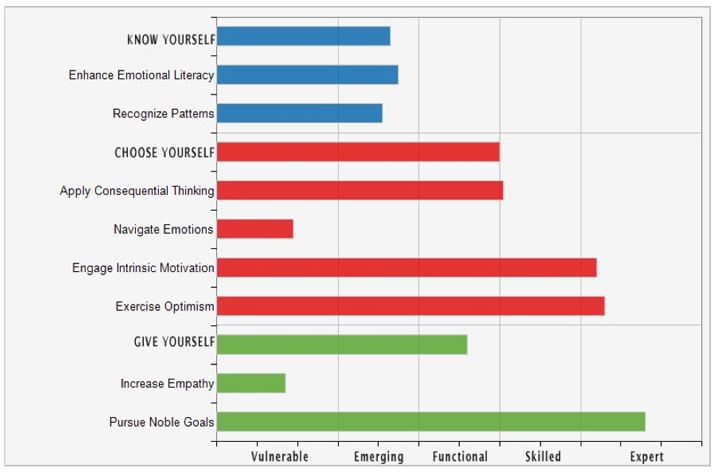
In the hands of skills practitioner, this data is incredibly powerful. We can make numerous inferences and begin to talk to “Hank” about some massive strengths — and what’s holding him back. Looking at the Navigate Emotions and Pursue Noble Goal scores, it’s evident that he’s emotionally disconnected from his own sense of purpose. He’s operating at a “head level.” The massive engines of Engage Intrinsic Motivation + Exercise Optimism might actually be running too fast, causing him to run people ragged — is it enough for him to be a sole star, or does he want a winning team? Based on the high PNG, we can leverage his vision to make a commitment to bringing others along. But for Hank, as for so many leaders, his first step is to increase the self-awareness. Until he tunes into what’s happening internally, he’ll keep tripping over these low scores. fortunately, he has the capability in Apply Consequential Thinking to see these risks… and the drive in EIM and PNG to do the work. Of course, the feedback from an assessment is just that: Feedback. We use the data to guide the conversation, and we support the client to reach her goals.
One of the key benefits of the SEI (which must be pretty interesting to you if you’re still reading – thank you) is that we actually have two questionnaires in one. We have the EQ scales, above, and we have a second questionnaire about key success factors. The results of this questionnaire fall into six categories, four of which appear in the current Leadership Report (all six appear on the Coach Data page as background for the Assessor). This enables us to have the “so what” — the reason the client will want to explore and develop EQ. In “Hank’s” case, his self-reported success factors, shown below, represent some serious concerns that he has, particularly about health and relationships, and a lot of room for improvement in other areas. The Assessor will use this data to help Hank frame up the need for change, and to understand his goals. Then, as we look at the EQ competencies above, it’s easy to start focusing the conversation on these key outcomes:
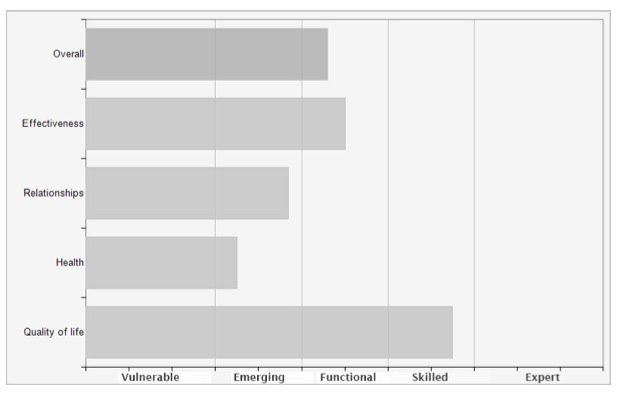
How does this work for business? 3 key cases
EQ for Business
Are your leaders great at leading people?
Most managers are promoted for their technical and business skills — but find the “soft side” hard.
“One of our biggest challenges is how to get more employee engagement under challenging times with diminishing resources. SEI has been an effective tool for identifying emotional intelligence issues and improving discretionary effort including ‘real world’ action plans for improving emotional intelligence.
We greatly appreciate the support, learning, and continuing research by the SEI team.”
– Bob Brooks, HR Advisor, FedEx
Engaging people in change, proactively resolving issues, setting a context for performance, building collaboration… they all require emotional competence. To change the outcomes, your leaders need to change the inputs — and to do so they need new awareness, attitude, and skills.
The Six Seconds Emotional Intelligence Assessment (SEI®) provides a solution to help leaders measurably improve in the people-side of performance. The tool assesses competence and delivers a practical roadmap for development. SEI scores predicts over 54% of important success factors: decision-making, influence, effectiveness, relationships, quality of life, and health — essential outcomes for thriving teams.
Check out these studies:
FedEx: 59.8% of leadership performance predicted by EQ.
New managers increased EQ by 12% yielding dramatic improvements in effectiveness. 6sec.org/fedex
Amadori: 76% of employee engagement predicted by EQ.
Higher EQ managers have a more committed workforce and drop turnover by 63%. 6sec.org/amadori
Komatsu: 9.4% increase in plant productivity.
In three months of integrating EQ to increase vitality, engagement doubled. 6sec.org/komatsu
The World Economic Forum’s “The Future of Jobs” research identifies emotional intelligence as one of the top skills for the future. Why? Today, success requires collaboration, influencing across boundaries, and navigating complexity — skills that are fueled by emotional intelligence (or “EQ”). But it’s not enough to “have” the skills — results come from using them. That’s why SEI offers a robust framework for putting EQ into action, including the world’s first machine-learning neural network for translating EQ data to practical action steps.
What are typical uses of SEI?
Uses of the SEI
The toolset is wide and deep. The Brain Profiles are perfect for training. The in-depth reports are perfect of long-term development programs and coaching.
In addition, the custom reports on SEI apply the model to specific areas from change to trust to sales to spiritual growth.
Typical uses include:
- Professional and personal development
- Training and coaching (for example… leadership, teamwork, performance management, stress, communication, people-skills for project management, etc)
- Selection, talent management
- Pre/Post assessment and research
Explore the SEI Tools and Custom Reports
Leadership Report
The flagship tool for growing the EQ capabilities to lead effectively – with and through people.
Neural Network
The most advanced analytics of any EQ tool on the market, guides people to practical application of emotional intelligence
Development Report
In-depth feedback on EQ competencies and their impact on life success, plus specific methods to grow EQ
Group Development Report
Structured framework to engage a group or team in why & how to develop EQ
Unlocking EQ Profile
The perfect tool to introduce EQ and get actionable feedback on using EQ to drive results
360
In-depth, multi-rater feedback tool that measure emotional intelligence performance – or how your EQ is showing up and impacting others
Brain Profiles
Snapshots of your brain’s styles and talents to effectively use emotional + cognitive data
Youth Version
A powerful tool for measuring and developing a child’s emotional intelligence
Perspective on Youth
Measures child’s emotional intelligence capabilities from the perspective of the adults in that child’s life
Go further with the custom tools applying EQ to meet specific needs
Next Steps
To be trained to use the SEI with others, register for a virtual or in-person emotional intelligence assessment certification.
To take the SEI and receive a debrief from one of our Certified SEI Coaches, or to learn more, contact us:




